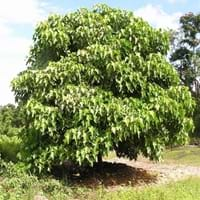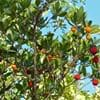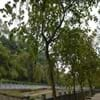Life Span
Perennial
Perennial
Origin
Mediterranean
Southeastern Asia, Melanesia, Micronesia, Polynesia
Types
Not Available
Not Available
Habitat
limestone outcrops, Rocky areas, Woodlands
Subtropical climates, Tropical regions
USDA Hardiness Zone
8-9
10-12
Sunset Zone
8, 9, 14, 15, 16, 17, 18, 19, 20, 21, 22, 23, 24
H2, 23, 24
Habit
Upright/Erect
Oval or Rounded
Flower Color
White, Light Pink
White
Flower Color Modifier
Bicolor
Bicolor
Fruit Color
Yellow, Red
Light Green, Gray Green
Leaf Color in Spring
Dark Green
Green, Gray Green, Gray
Leaf Color in Summer
Dark Green
Green, Gray Green, Gray
Leaf Color in Fall
Dark Green
Green, Gray Green
Leaf Color in Winter
Dark Green
Green
Leaf Shape
Orbiculate
Ovate
Plant Season
Spring, Summer, Fall, Winter
Spring, Summer, Fall, Winter
Sunlight
Full Sun, Partial Sun
Full Sun, Partial Sun
Growth Rate
Slow
Very Fast
Type of Soil
Loam, Sand
Loam, Sand
The pH of Soil
Acidic, Neutral
Acidic, Neutral, Alkaline
Soil Drainage
Well drained
Well drained
Bloom Time
Spring, Late Spring, Early Summer, Summer, Late Summer, Early Fall, Fall, Late Fall
Indeterminate
Tolerances
Drought
Wet Site, Drought, Salt
Where to Plant?
Ground
Ground
How to Plant?
Seedlings
Seedlings, Stem Planting
Plant Maintenance
Medium
Medium
Watering Requirements
Requires regular watering
Average Water Needs, Do Not over Water, Never Over-water, Requires a lot of watering
In Summer
Lots of watering
Lots of watering
In Spring
Moderate
Moderate
In Winter
Average Water
Average Water
Soil pH
Acidic, Neutral
Acidic, Neutral, Alkaline
Soil Type
Loam, Sand
Loam, Sand
Soil Drainage Capacity
Well drained
Well drained
Sun Exposure
Full Sun, Partial Sun
Full Sun, Partial Sun
Pruning
Prune in early spring, Prune in late winter, Remove damaged leaves, Remove dead branches, Remove dead leaves
No pruning needed
Fertilizers
All-Purpose Liquid Fertilizer
All-Purpose Liquid Fertilizer
Pests and Diseases
Red blotch
Red blotch
Plant Tolerance
Drought
Drought
Flower Petal Number
Single
Single
Foliage Texture
Medium
Medium
Foliage Sheen
Glossy
Matte
Attracts
Hummingbirds
Birds, Butterflies
Allergy
Hay fever, Oral Allergy, Skin irritation
Not Available
Aesthetic Uses
Beautification, Showy Purposes
Not Used For Aesthetic Purpose
Beauty Benefits
Not Available
Not Available
Environmental Uses
Air purification
Air purification
Medicinal Uses
Antioxidants
constipation, Diarrhea, Digestive disorders, Dysentry, Fever, Tooth ache
Part of Plant Used
Fruits
Fruits, Seeds
Other Uses
Traditional medicine, Used As Food, Used as Ornamental plant, Used for its medicinal properties
Making Shampoo, Making Sweet Scented Oil, Used As Food
Used As Indoor Plant
Yes
No
Used As Outdoor Plant
Yes
Yes
Garden Design
Shade Trees, Street Trees
Mixed Border, Shade Trees, Street Trees, Tropical
Botanical Name
ARBUTUS 'Marina'
ALEURITES moluccanus
Common Name
Marina Strawberry Tree, Strawberry Tree
Candleberry, Candlenut, Kukui
In Hindi
झरबेरी पेड़
candlenut पेड़
In German
Erdbeerbaum
Candlenut Baum
In French
arbousier
arbre Candlenut
In Spanish
Árbol de fresa
árbol candlenut
In Greek
φράουλα δέντρο
candlenut δέντρο
In Portuguese
medronheiro
candlenut árvore
In Polish
Strawberry Tree
Tung Molukański drzewo
In Latin
arbutus
Candlenut ligno
Phylum
Magnoliophyta
Spermatophyta
Class
Magnoliopsida
Dicotyledonae
Order
Ericales
Malpighiales
Family
Ericaceae
Euphorbiaceae
Clade
Angiosperms, Asterids, Eudicots
Angiosperms, Eudicots, Rosids
Tribe
Not Available
Aleuritideae
Subfamily
Not Available
Crotonoideae
Number of Species
Not Available
Not Available
Properties of Strawberry Tree and Candlenut
Wondering what are the properties of Strawberry Tree and Candlenut? We provide you with everything About Strawberry Tree and Candlenut. Strawberry Tree doesn't have thorns and Candlenut doesn't have thorns. Also Strawberry Tree does not have fragrant flowers. Strawberry Tree has allergic reactions like Hay fever, Oral Allergy and Skin irritation and Candlenut has allergic reactions like Hay fever, Oral Allergy and Skin irritation. Compare all the properties and characteristics of these two plants. Find out which of these plant can be used as indoor plant. If you are interested to decorate your house and garden, find out aesthetic uses, compare them and select the plant which will beautify your surrounding. Along with beautification, try comparing medicinal and edible uses of Strawberry Tree and Candlenut and you can choose the plant having best and most benefits.
Season and Care of Strawberry Tree and Candlenut
Season and care of Strawberry Tree and Candlenut is important to know. While considering everything about Strawberry Tree and Candlenut Care, growing season is an essential factor. Strawberry Tree season is Spring, Summer, Fall and Winter and Candlenut season is Spring, Summer, Fall and Winter. The type of soil for Strawberry Tree is Loam, Sand and for Candlenut is Loam, Sand while the PH of soil for Strawberry Tree is Acidic, Neutral and for Candlenut is Acidic, Neutral, Alkaline.
Strawberry Tree and Candlenut Physical Information
Strawberry Tree and Candlenut physical information is very important for comparison. Strawberry Tree height is 1,220.00 cm and width 610.00 cm whereas Candlenut height is 1,370.00 cm and width 1,520.00 cm. The color specification of Strawberry Tree and Candlenut are as follows:
Strawberry Tree flower color: White and Light Pink
Strawberry Tree leaf color: Dark Green
Candlenut flower color: White
- Candlenut leaf color: Green, Gray Green and Gray
Care of Strawberry Tree and Candlenut
Care of Strawberry Tree and Candlenut include pruning, fertilizers, watering etc. Strawberry Tree pruning is done Prune in early spring, Prune in late winter, Remove damaged leaves, Remove dead branches and Remove dead leaves and Candlenut pruning is done No pruning needed. In summer Strawberry Tree needs Lots of watering and in winter, it needs Average Water. Whereas, in summer Candlenut needs Lots of watering and in winter, it needs Average Water.





